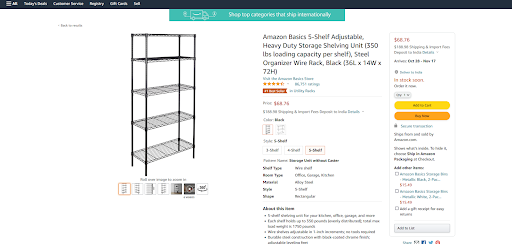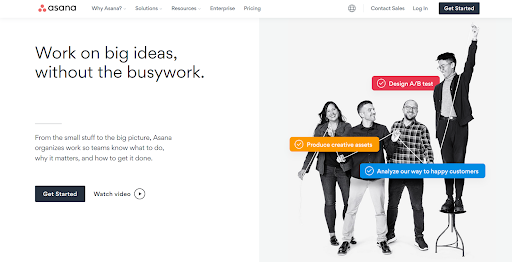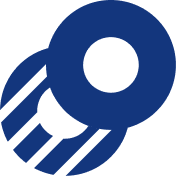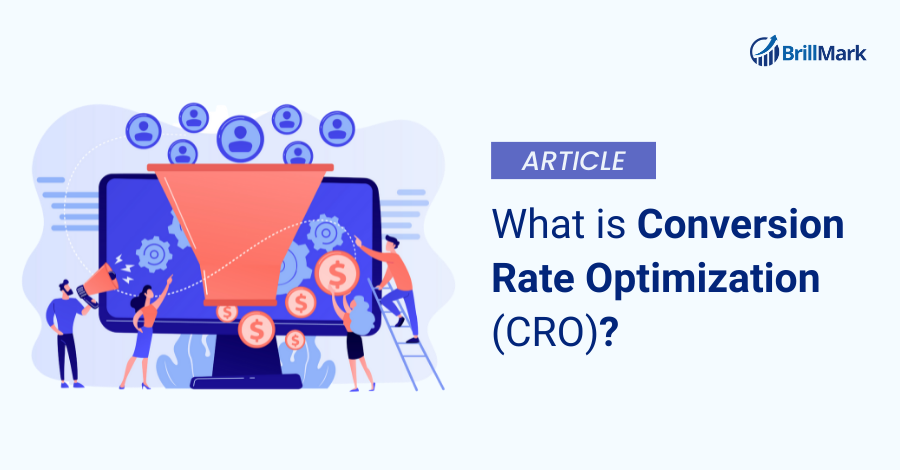Any business with an online presence getting more conversions, clicks, visits, and reach is essential.
According to Econsultancy, “Only 22% of businesses are satisfied with their conversion rates.”
And if you’re reading this, your business falls into this category. It also means your business needs to focus on Conversion Rate Optimization (CRO).
Read on to find out why-
Effective conversion rate optimization is the most excellent method to increase conversions.
In other words, conversion rate optimization assists you in better understanding your website’s usability while also providing two things:
- Insights into consumer behavior.
- Recommendations on how to improve your website’s UX to achieve your objectives.
Unfortunately, the “ongoing” part is typically overlooked when addressing conversion rate improvement.
As a CRO experimentation agency , we can share that CRO is not just about ideas, dynamics, and experiments; it’s much more. Conversion Rate Optimization helps you discover the perfect combination of elements that will work best for your site and bring in more conversions.
What Is Conversion Rate Optimization?
Conversion rate optimization is a scientific approach to increasing the percentage of visitors who turn into customers. It uses collected data, analytics, and ideas to prepare a hypothesis on how to improve conversions.
Then, you’ll use A/B testing tools to prove your hypothesis and achieve your desired goals.
Conversion rate optimization (CRO) is vital in today’s industry due to its impact on the bottom line. The Google Trends graph below shows it gaining popularity.

A successful conversion rate optimization campaign will not only result in significant savings in terms of time, money, and effort, but it will also allow you to explore new growth tactics that were previously unexplored.
CRO is a complex topic, but ultimately it only has one goal: to increase the conversion rate.
What Does “Conversion Rate” Mean?
“Conversion rate” refers to the percentage of visitors to your website who complete the desired action in a given time.
For example, imagine a website aims to convert people through a specific product landing page. If that page gets 1,000 visitors in a month and 100 of those visitors make a purchase, the page’s conversion rate is 10%.
Why Conversion Rate Optimization?
It assists you in better understanding your customers.
Understanding your customers is critical if you want to succeed as an online retailer. This is where conversion rate optimization (CRO) may help you enhance your whole online operation.
It’s essential to understand who your customers are when conducting conversion rate optimization research. Testing is integral to learning who exactly you are dealing with, what they want, and how you can give them that through your site.
It improves the quality and speed of tests performed on your website.
By using conversion rate optimization (CRO), you can assess the performance of your website by performing tests and looking for the best potential variants that promise to increase sales.
While testing and experimenting with different components on your landing pages, you can not only determine which aspects are producing the best results, but you can also utilize the data obtained as a fundamental benchmark for your next round of tests and experiments.
It increases income from the same amount of traffic and increases business returns.
Conversion rate optimization can benefit any e-commerce company looking to increase its revenue.
Suppose a company can increase its conversion rate by even a tiny percentage (2%) due to an A/B test. In that case, that means it is generating an additional 2% in revenue consistently.
Meanwhile, for businesses with a high sales volume, a 2% increase in sales might translate into hundreds of thousands or even millions of dollars in additional revenue.
It improves insights into the behavior of your visitors.
Using technologies such as heatmaps and click maps, the CRO process begins with gaining knowledge of consumer behavior. Such technologies can inform you which areas your website visitors spend the most time on.
Other conversion rate optimization techniques, such as user session recordings and session replays, aid in the understanding of the user’s entire experience. Such qualitative data is sufficient to produce a positive user experience and, as a result, to pave the path for conversions.
Elements for Conversion Rate Optimization (CRO)
Landing Page Design
The design of the landing page is the first thing your (potential) customers see when they visit your website. Having a website that is visually pleasing and usable will attract customers and entice them to spend time (and money) on your product.
For instance, the smallest amount of information on the Amazon product page is prominently shown on each page, thanks to the company’s strategic design.
When on a product page, customers can instantly add the product to their cart by clicking on the “Add to Cart” button next to the product information column.

In addition, the efficient use of white space to highlight product characteristics and the intelligent use of large images on the left side of the page inspire confidence and quickly grab visitors’ attention.
Web Page Loading Time
Slow page load times have a significant influence on the overall performance of your website. It also directly impacts users’ experience, the site’s conversion rate, and the site’s ranking on search engine results pages.
According to Semrush, if a website loads in 1.7 seconds, it’s quicker than 75% of the pages on the web. When it loads in 0.8 seconds, on the other hand, it is faster than roughly 94% of all online pages on a given day.
Even a one-second delay in loading time can result in a 7% reduction in conversions. For example, if your website generates $10,00,000 in sales per day, even a one-second delay in its loading time might cost you around $70,000 per day or more in lost income.
As a result of the same one-second wait, you’re at risk of losing around 11% of your potential clients, who will dismiss your website or exit without giving it a second thought.
Website Copy
In addition to increasing user engagement, well-designed and visually appealing websites can hook customers, converting them into potential leads.
It can make all the difference between visitors staying on your website and completing your set goals and leaving without taking any action.

Consider the landing page of Asana, a modern collaboration hub area that enables teams to remain connected and collaborate on projects. It features a powerful title followed by content that focuses on its unique selling propositions.
Call-to-Action (CTA)
A call-to-action (CTA) is precisely what it sounds like: an invitation or request for customers to perform the desired action on your website. Any activities, ranging from signing up for a newsletter to reserving a seat in a webinar, making a buying choice, or using a service, are examples of a CTA.
Forms
Forms play an essential part in the success of most businesses, primarily if they are used as part of the sales funnel. Prioritizing and optimizing these critical customer touchpoints can significantly impact your conversion rate.
While numerous ideas are presented on creating a decent and successful form for your website, these theories may or may not apply to all situations.
A comprehensive form can be beneficial in some situations, but succinct forms can be very effective in others, especially when conversions are climbing the graph.
The key here is to balance lead quality and lead volume constantly to get the highest possible return on investment.
Sitemap and Navigation
Your website structure should be focused on creating an easy-to-navigate experience. At its most basic level, site structure is often represented as a graph depicting how different pages on your site interact with one another.
Typically, you begin your navigation from the homepage and work your way through the site’s many categories and subcategories until you find what you were searching for in the first place.
As long as the whole process goes smoothly, your users will have no trouble navigating the website. But if your site is not well organized, there is a possibility that your visitors will become disoriented and eventually leave your site without completing desired action(s).
To deal with this, it’s necessary to guarantee that visitors can travel between essential website areas quickly and simply and locate everything they need to fulfill their goals with the smallest number of clicks possible.
In other words, developing a website that is fluid and easy to use is critical to improving conversions as well as the reputation of your company.
What you need to get started with CRO
Like any other digital marketing effort, you need a plan or CRO strategy before you can begin.
The first step is data collection, or analyzing what you already know about conversions on your site. You need to examine:
- What is preventing conversions on-site?
- Which pages or elements will provide the most benefit if improved.
You can start this process by looking into your Google Analytics. Look for pages with high organic traffic or low bounce rates that aren’t performing well in conversions. You can also investigate user behavior using CRO tools such as heatmaps or Hotjar, among other valuable tools.
Once you better understand the issues and opportunities, you can set the hypothesis. A hypothesis may be something like:
Website users frequently abandon their carts when they move to a new page. This often happens when they move from product pages to top-level category pages. Could this be improved by adding more “add to cart” buttons on the category pages?
Later, you will use CRO testing tools to verify your hypothesis and tweak it if necessary.
How Conversion Rate Optimization Tools Can Help
As the digital landscape grew in the early 2000s, website marketers began searching for ways to enhance the user experience and encourage more sales.
This hustle led to new conversion rate optimization tools such as Google Analytics, Google Optimize, Survey Monkey, Hotjar, Crazy Egg, etc., opening the doors to CRO testing and analysis.
Marketers began to play around with website design, content, visuals, and other elements to enhance their conversion rates.
According to Wordstream, “CRO tools have an average ROI of 223%.”
Let’s go back to the example from above. Imagine if the website focusing on that particular product page managed to use CRO tools to increase its conversion rate for that page from 10% to 15%. This would increase conversions by 50% — likely a massive benefit for the bottom line.
Now imagine what would happen if a conversion rate optimization agency were to help the business analyze the rest of its product pages. The improvement in overall conversions could be astronomical.
Conversion Rate Optimization Process
Step 1: Conducting Research and Obtaining Data
Marketers tend to imitate the most popular conversion rate optimization techniques that have been shown to work for other companies.
However, they are unsuccessful. Why? Because it’s possible that what has worked for them will not work for you!
And this is why the research and data collection phases are of utmost importance. This will assist you in understanding how users are reacting to your site and why they behave in a specific manner.
Rather than optimizing based on gut instinct or imitating other well-performing CRO techniques, making data-supported judgments is preferable. You should thus track and assess your micro conversions before proceeding to the next step.
You can obtain data through Quantitative Data Analysis or Qualitative Data Analysis.
Quantitative Data Analysis
To understand how users are reacting to your website or landing page, quantitative data analysis is performed. Tools such as Google Analytics, Adobe Analytics, and others can assist you in collecting quantitative data.
Qualitative Data Analysis
Although quantitative data analysis is a good starting point, it can’t paint a comprehensive picture. It is unable to provide an answer to the “why” inquiries. And it is at this point that qualitative analysis comes into play.
Qualitative analysis is a subjective technique that seeks to understand why your consumers act in a particular way.
Step 2: Formulating a Hypothesis
It is time to formulate your hypothesis in light of the quantitative and qualitative evidence you have gathered.
Since you’ve completed your research, you can put your theory (based on statistical data) into action. But how can you be sure your hypothesis will be successful? A/B tests and multivariate testing come into play in this situation.
You may have uncovered many optimization options and hypotheses depending on your results from the previous steps. It might be challenging to take it all in at once. As a result, you’ll want to arrange everything according to importance. However, before moving to the testing step, you should prioritize your efforts.
Step 3: Establishing a List of Priorities
Prioritizing your hypotheses can help you concentrate your efforts on the most essential and severe issues on your site. To keep things concise, let’s take a brief look at the top prioritization frameworks out there:
“P.I.E. Framework” is an abbreviation for Personal Information Exchange Framework.
It was developed by Chris Goward of WiderFunnel and is referred to as the P.I.E. framework. The framework considers three factors: potential, importance, and ease of implementation.
Potential:
With your analytics data, customer feedback, and in-depth study of user situations, you must identify and rank your worst-performing sites on a scale of one to ten.
Importance:
Now that you’ve identified your poorest performers, it’s time to choose which of the following sites is the most important. So how do you define significance? Your most popular pages, which receive the most traffic and are the most expensive, are the solution to this problem. You can simply segregate these sites based on your web analytics data and begin ranking them on a scale of one to ten.
Ease:
The third factor to consider should be the simplicity with which your testing can be performed. A page with a lot of room for improvement and a lot of traffic can also have a lot of technical difficulties when it comes to running your tests. As a result, along with “Potential” and “Importance,” you must also consider the simplicity with which your sites may be optimized when ranking them.
Step 4: Implementation and Testing
This is one of the most crucial phases in the process of improving conversion rates on a website.
You should test and implement once you have completed your data analysis, hypothesis development, and prioritizing.
Testing your hypothesis may be accomplished in a variety of methods, the most common being:
A/B Testing
A/B testing is a research-based approach that compares the user experience between two variations, A and B. It is also known as split testing.
A minor optimization, such as a subtle design or layout modification, can be tested using this method.
Split Testing
Split testing, also known as split URL testing, is used to evaluate more complicated modifications before implementing them.
For better or worse, split testing compares two variants of a website that are accessible through two different URLs.
You may have to build a new page with a different URL if your design optimization needs are too demanding and complicated.
Multivariate Testing
This is a type of statistical analysis. Multivariate testing is used when you need to make numerous changes to a page while also testing each combination of changes individually.
However, you must have the best tools to do these tests. A/B testing, split tests, and multivariate tests may be accomplished with tools such as Google Optimize, Optimizely, and others.
Step 5: Educating Yourself and Reviewing Your Notes
Now that you have your test findings in front of you, you’ll either discover that your hypothesis was correct or that things did not turn out as you had anticipated. Generally speaking, if the findings of the tests are favorable, marketers are more likely to put the modifications into effect immediately.
However, if the results are unfavorable, they will return to the drawing board to create new theories. Even if your idea is right, you should continue your investigation, but always ensure the expense of implementing the modifications is proportionate to the amount of income they will generate.
Also, if your theory is incorrect, make sure to look for flaws in it before dismissing it altogether. Double-check your test findings as well as your research data before proceeding to develop a new hypothesis.
Best Practices of Conversion Rate Optimization
Typically, it’s best to enlist the support of a skilled CRO agency to help you improve the conversion rate across your site. If that’s not an option now, you’ll need to develop the hypothesis independently.
Let’s look at some CRO best practices to help you get started.
CRO Is More Than A/B Testing
This is a common misconception. But CRO is a systematic process or framework comprising quantitative and qualitative research, whereas A/B testing is only one strategy that helps us confirm our ideas or hypothesis.
A/B testing can tell us which version of our experiment performed better but not why. The CRO method excels at explaining the “why.” It helps us understand how and why people engage with our website.
Once we understand it, we can start investigating our conversion issues and testing our remedies.
Every Test Has a Hypothesis
Without a hypothesis, you don’t know what you’re testing. You don’t know if your test was successful. A hypothesis helps us identify the issue, offer a remedy, and determine its success. Every test should have a hypothesis.
This way, we know exactly what we’re testing, and what success looks like.
Start With Your Top Landing Pages
In general, it’s best to optimize the pages with higher traffic first, as they will be much easier to analyze and more clearly reflect significant changes in conversion rate.
Many businesses choose to start with their homepage, but there may be other pages, such as product or services landing pages, that have more opportunities. You’ll likely want to analyze more than one page, so at this stage, you’re only looking for the top two or three pages to get the most out of your CRO testing plan.
Setting Goals And Benchmarks
Once you know which pages hold the most opportunity, you must decide what you want to achieve. Your end goal is more revenue. But how you bring on the additional income will depend on several variables.
Rather than just looking for an increase in revenue, take a look at a few metrics that you could measure more effectively to see if your CRO testing plan is working.
For example, let’s say you’ve identified a landing page that gets a lot of traffic but doesn’t bring in many conversions. To help this page perform better, you could look to:
- Increase sign-ups on the landing page.
- Improve time-on-page.
- Increase return visits to the page.
The goals could differ depending on the site or app you are working on.
For example, your blog or news page will likely perform better with more clicks, shares, or email subscriptions.
On the other hand, e-commerce CRO efforts should aim for revenue increases, so goals could be increasing clicks, increasing sales, increasing sign-ups and “add to cart” clicks, reducing cart abandonment, etc.
What matters most is what your site needs to achieve, so come into this part of your experimentation with an open mind.
Goal Tracking
The last thing you want is to finish an experiment and then realize you didn’t have the appropriate tracking to verify its success.
The tracking measures total goal submissions, button clicks, link clicks, page visits, etc. This can be done at the page or event level. The good news is that the testing tool can define the goals for you if you’re not sure what the goals should be.
Defining the event click, link click, page destination, etc., is all you need to do. Then you can choose your pre-defined goals.
Building Your First CRO Campaign
If you know how to use tools like Google Analytics, you should be able to build a solid CRO hypothesis on your own. However, running effective A/B testing is a complex process, and often businesses need the help of CRO testing experts such as BrillMark.
We also work on Ecommerce conversion rate optimization
We help businesses move their hypotheses and goals into the experimentation stage. BrillMark can reliably build and execute complex experiments across any device, application, or platform.
With 10,000+ tests under our belt, we can tell you if your hypothesis is correct or needs to be adjusted or if you need to run additional variations.
Our experts can also build custom audiences beyond what the testing tools provide to segment your audience further and compare their unique behaviors.
BrillMark can also help you interpret the test results generated by the testing tool, consisting of the measurable factors affecting conversion rates of both the original pages and the variations we create. If the interpretation is proven to improve conversion rate and revenue, we’ll help you implement it across your site.
Want to know more about how BrillMark CRO testing can help your business win more leads and generate more revenue? Let’s talk testing or grab a spot on our calendar to schedule a 30-minute consultation.











